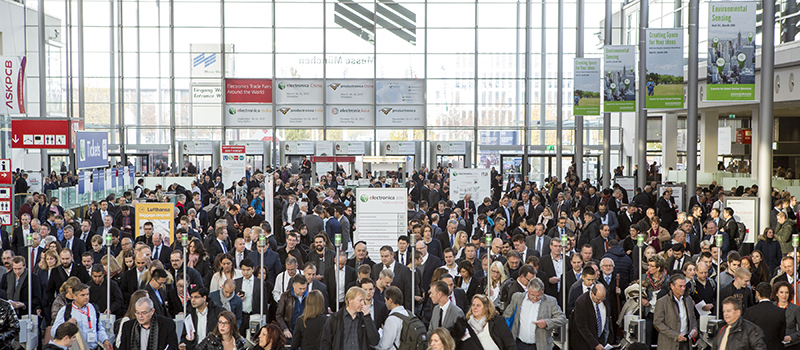Sensor technology: electronics with every sense
The digital world depends on data and that data increasingly comes from networked, intelligent sensor technology. As one of the key technologies for the future developments in IoT, autonomous driving, Industry 4.0, smart healthcare, and smart cities, visitors will find sensor technology in many of the sectors and events at electronica, held on 13th to 16th November, 2018.
Visitors will find the highest concentration of sensors in the ‘Sensor Technology, Micro and Nanosystems’ (Hall B3) and ‘Measuring and Checking’ (Hall A3) areas.
With the advent of the Internet of things, the Internet is continuing to make its presence felt in all areas of private and professional life. Sensors play a key role in this development, as they turn every ‘thing’ into a source of data. In so doing, they build bridges between the analogue and digital worlds in vehicles, smart cities, smart factories, smart homes, and in medicine.
The sheer variety of applications is leading to explosive growth in the number of different types of sensors available, all of them based on around a dozen basic measurement principles.
The development of smart sensors plays a particularly important role in this context. In addition to acquisition, sensors now also combine preparation and processing in a single component. With the help of microprocessors, sensors become interfaces with higher-level systems without the need for an external computer.
Sensor technology: the market
The VDE, a German electronics industry association, believes that the sensor market has enormous potential for growth. It predicts the number of sensors on the market will rise from ten billion currently to one hundred trillion by 2030. According to a survey by Germany's Association for Sensors and Measurement (AMA), the German sensor industry, which is overwhelmingly made up of SMEs, is particularly eager to embark on new research and investment programs.
Analysts from Zion Market Research believe that profits from IoT sensors will grow to $27.38bn by 2022, at a Compound Annual Growth Rate (CAGR) of over 24%. High sales figures will come courtesy of Industry 4.0 and the automotive sector, as well as from medical electronics. That's why sensors play a leading role in many areas of the electronica 2018 exhibition, as well as in the conferences taking place around the event.
Sensor technology: the conferences
One place you can find them is the electronica Automotive Conference (eAC), to be held on 12th November, 2018. Over a few short years, driver assistance systems and comfort functions have led to an enormous increase in the number and variety of sensors on the market. The electrification of drive systems, autonomous driving and connectivity will accelerate this trend even further over the coming decade. Sensors are subject not only to demanding technical requirements, but also to increasingly high expectations regarding cost, miniaturisation, strength, and reliability. Even so, meeting the safety requirements for autonomous driving requires the use of multi-sensor systems and combining the data from the widest possible range of sensors (sensor fusion).
Sensor technology will play a similarly crucial role at the electronica Embedded Platforms Conference (eEPC) on 14th and 15th November, 2018. In innovative embedded systems, sensors no longer simply perceive the world around them; they process the measurements they take and increasingly act on them autonomously using machine learning algorithms. In Embedded Vision, sensors are opening up completely new fields for small, smart, image processing systems in the factory of the future, in traffic management, in medicine, and in consumer goods.
The inaugural electronica Medical Electronics Conference (eMEC) on 15th November, 2018 will host a range of sensor-based wireless systems designed to gather medical data. In the future, this technology will make individually tailored medical care both cheaper and more effective. To do so, however, it will have to meet the medical sector's stringent accuracy and reliability requirements. Applications for use close to the body require the development of additional bio-compatible sensor housings as well as secure, gas-tight encapsulations.

Sensor technology: the forums
Manufacturers, specialists and technical managers can take a look at the latest trends in sensor technology and discuss the latest market and technological developments with experts and colleagues on all four days of the Automotive Forum (Hall B4), Embedded Forum (Hall B5) and IoT Forum (Hall C5). A new addition this year is ‘TechTalks’, a format focusing on technical depth and explicitly targeted at engineers and developers. Entry to all electronica forums is included in the ticket price.
Sensor technology: the exhibitors
The exhibition areas Sensor Technology, Micro and Nanosystems (Hall B3), Measurement and Checking (Hall A3), Embedded (Hall B5), and Automotive (Hall B4) cover the full spectrum of sensor technology from hardware and software right through to complex systems and services.
This allows Fraunhofer IIS to combine sensors with algorithms for data analysis directly within the machine itself, making errors quick and easy to find as well as allowing manufacturing processes to be optimised independently by testing systems.
First Sensor's digital HDR-CMOS cameras, alongside solid-state lidar sensors by Osram, the world's leading provider of sensor lights for autonomous vehicles, are essential prerequisites for partially and fully autonomous driving.
The AI control box from ZF Friedrichshafen and AI specialists Nvidia processes the enormous data flows generated by a comprehensive range of sensors in real time, allowing level four autonomous driving.
The combination of extremely low energy consumption and long-term stability makes Sensirion’s sensors perfect for monitoring air quality in mobile and battery-driven smart home applications.
Bosch, the world's leading manufacturer of MEMS sensors for automobiles and consumer electronics, is exhibiting sensors with a measurement unit in a semi-conductor housing.
TE Connectivity provides sensor solutions to meet the stringent requirements of many medical applications.
Members of the Association for Sensors and Measurement (AMA) will use their shared stand to show everything from sensor elements to sensors and measuring technology, right through to system and complete solutions.










